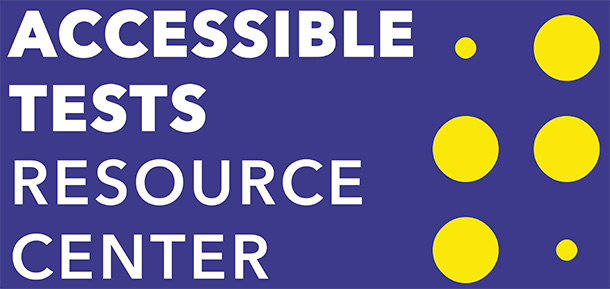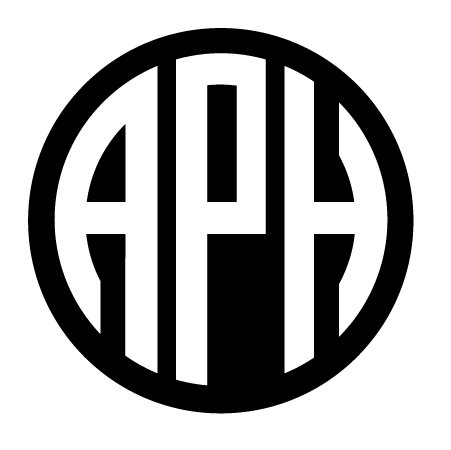Go to navigation for Accessible Tests Resource Center
Research and Resources
Research results as well as studies that are underway, and a wide variety of resources from websites, webinars, position papers, white papers, presentations, and publications related to assessment.
Position Papers
Intelligence Testing of Individuals Who Are Blind or Visually Impaired
By Stephen Goodman, Carol Evans, and Marnee Loftin
Published by the American Printing House for the Blind (APH), Louisville, KY
© APH 2011
Appendix D: Use of an Abacus in Test-Taking Situations
By Terrie Terlau and Fred Gissoni
Published by the American Printing House for the Blind (APH), Louisville, KY
© APH 2009
Resources
ACCESS to Resources: For Students with Disabilities, sixth edition, © 2015
This guide, referred to as ACCESS, is divided into five general categories and an Appendix:
- Education and Training
- Daily Living Skills
- Assistive Technology
- Laws and Rights
- Specific Population Resources
- Appendix
Thanks to the generosity of the California Transition Alliance, ACCESS is available free.
American Printing House for the Blind (APH) Databases
The Louis Database contains information on approximately 414,657 titles in accessible formats that include Braille, large print, sound recording, and electronic files. From there you can also access a number of Related Sites listed in the lower left corner. Related Sites include the following:
Accessible Media Producers (AMP) Directory is a self-listing directory of producers of accessible formats such as braille, tactile graphics, large print, e-text, and audio.
Publisher Contacts for braille-related materials and questions.
APH’s APH Tactile Graphic Image Library (TGIL) contains a pool of well-designed templates to aid in the creation of tactile graphics. This database continues to be populated with new images on a regular basis. Register for a free account to get started with using this database.
TGIL 2.0 features improvements that make this database more accessible and intuitive. Also, a forum for tactile graphic discussions has been added to aid in your design and production of high quality, readable tactile graphics.
American Printing House for the Blind (APH) Website
The main website for the American Printing House for the Blind offers an abundance of information related to products and services available for students who are blind or visually impaired.
The APH Shopping Site provides software demos and tech products as well as downloadable product manuals.
The Handy Lists include new products available, recommended products for the instruction and/or assessment of students who are blind or visually impaired, braille code instruction and braille codebooks, and more.
The APH Catalog includes the APH Accessible Products Catalog Download Centeer and APH Catalogs by mail, if you would like to have hard copy catalogs.
The Videos and Webcasts section includes Videos and Webcasts about Products and Services, and Quick Tips Videos.
Related information such as APH’s mission, contact information, how to get free quotes on producing materials in accessible media, having materials reviewed for accessibility and/or bias, ordering custom products in accessible media, research resources, Fred’s Head database of commonly asked questions and responses, information and products on cortical visual impairment, physical education, and so much more can be found on the APH website. Please contact APH if you have questions, concerns, or need a free quote to have your materials reviewed and/or produced in accessible media.
American Printing House for the Blind: 2016-2017 Instructional Products Catalog and Parts Catalog
The Instructional Products Catalog and Parts Catalog is available online as well as in hard copy.
This Catalog’s Table of Contents will give you an idea of the types of products described in this catalog that are available from the American Printing House for the Blind (APH).
Table of Contents:
- Introduction
- Assessment
- Early Childhood
- Core Curriculum
- English Language Arts
- Mathematics
- Science and Health
- Social Studies: History, Geography, and Economics
- Fine Arts
- Business and Vocational Education
- Physical Education
- Expanded Core Curriculum
- Communication Modes and Literacy Education
- Visual Efficiency and Low Vision
- Orientation and Mobility (Concept Development)
- Assistive Technology and Electronics
- Career Education and Transition
- Self-Determination
- Daily Living and Social Interaction
- Videos
- Resources for Professionals
- “Special Touch” Gift Items
- Replacement Parts Catalog
- Other Services from APH
- How to Order, Returns Policy, Warranty and Repair Policy
Assistive Technologies: Principles & Practices by Albert M. Cook and Jan Miller Polgar; 4th edition
© 2015 by Mosby, Inc., an affiliate of Elsevier, Inc.
The back cover states that the content of this book helps you to “understand the current strategies and information you need to make confident clinical decisions about assistive technology devices, services, and practices.”
Content includes the following chapters and back matter:
- Principles of Assistive Technology: Introducing the Human Activity Assistive Technology Model
- Technologies That Assist People Who Have Disabilities
- Activity, Human, and Context: The Human Doing an Activity in Context
- Ethical Issues in Assistive Technology
- Delivering Assistive Technology Services to the Consumer
- Making the Connection: User Inputs for Assistive Technologies
- Control Interfaces for Assistive Technologies
- Accessing Mainstream Information and Communication Technologies: The Technology and the Web
- Enabling Function and Participation with Seating Technologies
- Technologies that Enable Mobility
- Technologies that Aid Transportation
- Technologies that Aid Manipulation and Control of the Environment
- Sensory Aids for Persons with Visual Impairments
- Sensory Aids for Persons with Auditory Impairment
- Assistive Technologies for Cognitive Augmentation
- Resources for Further Information
- Glossary
- Index
- Each chapter includes a chapter outline, learning objectives, key terms, chapter content, summary, study questions, and references.
Books in APH Library
The Complete Dictionary for People with Disabilities (2016 Twenty Fourth Edition)
Sedgwick Press Book: Grey House Publishing © 2015
Descriptive listings in The Complete Directory for People with Disabilities are organized into 31 chapters by either resource type or disability category type. You will find the following types of listings throughout the book:
- National Agencies & Associations
- State Agencies & Associations
- Camps & Exchange Programs
- Manufacturers of Assistive Devices, Clothing, Computer Equipment & Supplies
- Print & Electronic Media
- Living Centers & Facilities
- Conferences & Trade Shows
Grey House Publishing
4919 Route 22, P.O. Box 56
Amenia, NY 12501
Related to book above is an online database:
Grey House Online Databases
Visit http://gold.greyhouse.com for information.
eSchool News: Daily Tech News & Innovation
eSchool News Online covers education technology in all its aspects—from legislation and litigation to case studies, to purchasing practices and new products.
First published in March 1998, eSchool News is a monthly print and digital newspaper providing the news and information needed to help K-20 decision-makers successfully use technology and the internet…(to) achieve their educational goals.
eSchool News Online includes the following main categories:
- Top Trends
- Technology
- Thought Leadership
- Digital Curriculum
- Colleague Corner
- Resources
- Webinars
Equal Access to Software & Information (EASI)
Equal Access to Software & Information (EASI) is the premier provider of online training on accessible information technology for persons with disabilities. Visit EASI for information regarding companies and organizations working together, conferences, live and archived webinars, courses, two membership programs, and more.
National Center on Accessible Educational Materials (AEM)
National Center on Accessible Educational Materials (AEM). Listed are the following Accessibility Organizations and Resources accompanied by links and brief information on each organization or resource:
- A11Y
- Accessibility and Open Educational Resources (OERs)
- Benetech Born Accessible Resources
- GSA 508 Tutorials, Guidance, Checklists
- Inclusive Design Research Centre (IDRC)
- The International Association of Accessibility Professionals (IAAP)
- The International Digital Publishing Forum (IDPF): EPUB 3 Accessibility
- Knowbility
- Merlot Resources
- United States Access Board and Section 508 Guidelines and Standards
- W3C Web Access Initiative Content Accessibility Guidelines & Techniques
- WebAIM
Listed are Corporate Accessibility Resources—General accompanied by a link to each. These include:
- Adobe Accessiblity Resources
- IBM Accessibility
- IBM Web Resources for Accessibility
- Microsoft Accessibility
Listed are Corporate Accessibility Resources—Product Specific accompanied by a link to each. These include:
- Adobe Accessibility by Product
- Adobe & Accessibility
- Amazon Fire Tablet Accessibility Features
- Apple Accessibility
- Facebook Accessibility
- Google Accessibility
- Accessibility in Microsoft Products
National Center on Educational Outcomes (NCEO)
According to NCEO’s website, this organization has been
- working with states and federal agencies to identify important outcomes of education for students with disabilities, English language learners (ELLs), and ELLs with disabilities.
- examining the participation of students in national and state assessments, including the use of accommodations and alternate assessments.
- evaluating national and state practices in reporting assessment information on students with disabilities, ELLs, and ELLs with disabilities.
- bridging general education, special education, English as a Second Language or bilingual education, and other systems as they work to increase accountability for results of education for all students.
- conducting directed research in the area of assessment and accountability.
Again, according to NCEO’s website, this organization focuses its efforts in the following areas:
- Knowledge Development on the participation and performance of students with disabilities, English language learners (ELLs), and ELLs with disabilities in state and national assessments and other educational reform efforts.
- Technical Assistance and Dissemination through publications, presentations, technical assistance, and other networking activities.
- Leadership and Coordination to build on the expertise of others and to develop leaders who can conduct needed research and provide additional technical assistance. The NCEO website confirms that NCEO offers the following kinds of materials and services for state personnel, educators, parents, and others concerned with the educational outcomes of all students:
- An extensive publications list that includes technical reports, state activity updates, policy documents, and self-study guides.
- Criteria for evaluating existing policies on large-scale assessments.
- Recommendations for developing assessment policies and guidelines for participation, accommodations, reporting an accountability that include all students.
- Current information on assessment projects and other efforts to collect data on the educational outcomes of all students.
- A national network of people who can assist states and other agencies as they consider assessment issues.
NCEO’s website states that NCEO works in collaboration with the
- Council of Chief State School Officers (CCSSO), and the
- National Association of State Directors of Special Education (NASDSE)
For additional information, contact
National Center on Educational Outcomes
Martha Thurlow, Ph.D., NCEO Director
University of Minnesota
207 Pattee Hall
150 Pillsbury Dr. SE
Minneapolis, MN 55455
612-626-1530
Fax: 612/624-0879
nceo@umn.edu
National Federation of the Blind (NFB)
National Federation of the Blind (NFB) improves blind people’s lives through advocacy, education, research, technology, and programs encouraging independence and self-confidence.” Information at this site includes disability training, disability law, disability services, and more.
The National Federation of the Blind provides the following programs:
- NFB Link pairs individuals who are blind or visually impaired and seeking a mentor and/or information with an experienced Federationist.
- NFB Newsline is a digital talking newspaper for blind individuals.
- Race for Independence is a blind driver’s challenge.
- NFB Youth Slam is a 4-day event to encourage youth who are blind or visually impaired to pursue careers in the STEM areas (science, technology, engineering, and mathematics).
- Braille is Beautiful teaches sighted students how to read and write in braille.
- Additional NFB programs include the NFB Scholarship Program and the Braille Readers are Leaders Program.
Paths to Literacy: for students who are blind or visually impaired
Paths to Literacy is “an online hub for information related to literacy for students who are blind or visually impaired, including those with additional disabilities or deafblindness. It includes original content, as well as links to other sites and resources available on the web.”
Menu items include:
- General Literacy
- LMA (Learning Media Assessment)
- Emergent Literacy
- Multiple Disabilities
- Braille
- Struggling Readers
- Writing
- Dual Media
- English Language Learners
- Auditory Strategies
- Math Literacy
Posts related to Technology include the following:
- Aipoly Vision App
- Free App to Get Started with (Mac computers) VoiceOver
- LEAP Games Using Binaural Sound
- Free Text to Speech
- Scanning a Print Document and Filling Out on the iPad
- iPad Accessibility Webcast
- Free iBook to Prepare Children for Eye Exam
- Setting Up Accessibility Features on Chromebook
- Video Demonstration of Elmo Document Camera for iPad
- Video Demonstration of APH Orion TI-84 Plus Talking Graphing Calculator
- Learn to Format Accessible Documents
- Lesson Plan: iOS VoiceOver Gestures Practice
- Free Android Apps for Children with Visual Impairments
- Braille Note Taker Curriculum
- Nemeth/Braille Sense Video Tutorial
- Including ALL Students in Transition from Paper Classroom to Digital Classroom
- VNC Viewer App
- to Speech
- Scanning a Print Document and Filling Out on the iPad
- iPad Accessibility Webcast
- Free iBook to Prepare Children for Eye Exam
- Setting Up Accessibility Features on Chromebook
- Video Demonstration of Elmo Document Camera for iPad
- Video Demonstration of APH Orion TI-84 Plus Talking Graphing Calculator
- Learn to Format Accessible Documents
- Lesson Plan: iOS VoiceOver Gestures Practice
- Free Android Apps for Children with Visual Impairments
- Braille Note Taker Curriculum
- Nemeth/Braille Sense Video Tutorial
- Including ALL Students in Transition from Paper Classroom to Digital Classroom
- VNC Viewer App
- How to Convert Bookshare Books to ePub & Dropbox NIMAC Textbooks for a Student
- Using Bookshare and Voice Dream Reader to Make Reading Accessible
- iZiggi Document Camera
- …and too many more to list!
Posts related to Research include:
- Results of WebAim Screen Reader Survey
- Youth Share Their Experiences in a Research Study on Braille and Tactile Graphics
- Guide to Designing Tactile Illustrations for Children’s Books
- Research Synthesis of Tactile and Object Exploration
- Results of Screen Reader Survey
- Research on Accessible Technology
- Online Survey about Common Core
- …and so much more!
Teaching Students with Visual Impairments
If you need visual impairment program information and resources, eligibility information, evaluation assessments, Individualized Education Program (IEP) information, the need for adapted materials explained, Expanded Core Curriculum (ECC) ideas, or information about useful apps, then Teaching Students with Visual Impairments will be useful to you.
Texas School for the Blind and Visually Impaired (TSBVI)
Resources on Texas School for the Blind and Visually Impaired (TSBVI)‘s website include a wealth of information on topics that address the following issues and more:
- Orientation & mobility (O&M)
- Assistive technology (AT)
- Administrator’s toolbox
- Accessibility notes
- Apple Device Resources
- Braille Instructional Resources
- Clinical Low Vision Service Providers
- Community Partners
- Cooking & Recipes
- CVI Exercise
- ESC Personnel
- Eye Find
- Guidelines
- Instructional Resources
- Library & Braille Book Downloads
- Math
- National Agenda
- Professional Prep
- Resources for Keyword Tag
- Resources for Expanded Core Curriculum (RECC)
- Robotics
- Staffing Pattern for Itinerant Teacher of Students with Visual Impairments
- Specific Eye Conditions, Corresponding Impact on Vision, and Related Educational Considerations
- Tactile Symbols
- Technology
- TSBVI History Sites
- TX SenseAbilities`
- Vision Syndromes
- VISSIT
- Bioptic Driving Exercise #1
- Bioptic Driving Exercise #2
- Passenger-in-Car Skills
- Using an Abacus and the Counting Method
- The importance of Touch in Parent-Infant Bonding
- O&M: Infants and Beyond
- Natasha and the Big Old Goofy World
- Incorporating Active Learning Theory into Activity Routines
- Five Phases of Educational Treatment Used in Active Learning based on excerpts from Are You Blind? by Dr. Lilli Nielsen
- Autism in the VI Child
- O&M Training for Students Who Are Deafblind; Going Beyond the Blue Book
- A Place for Everything and Everything in its Place
- Example Form: Assessment of Biobehavioral States and Analysis of Related Influences
Wechsler Intelligence Tests
If you have questions regarding the Wechsler scales and using them with clients who are blind or visually impaired, please feel free to contact:
David W. Frensley, M.A.
Licensed Senior Psychological Examiner
Tennessee School for the Blind
Tennessee Association of School Psychologists
Tennessee Psychological Association
American Academy of Clinical Neuropsychologists
(615) 231-7315
This resource is being provided with permission from David W. Frensley.


